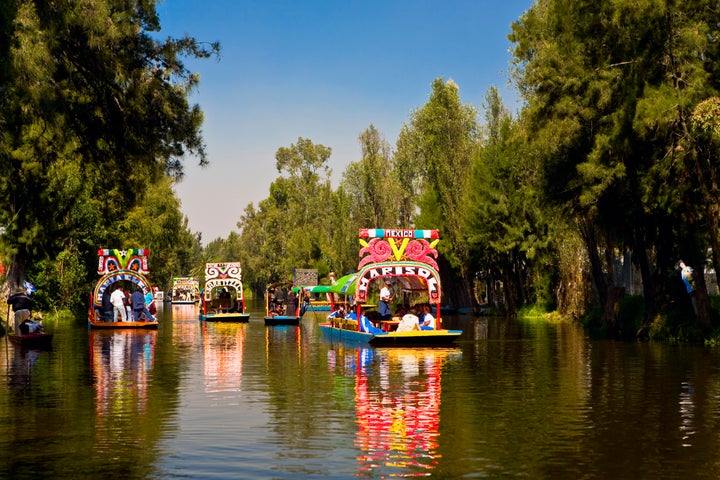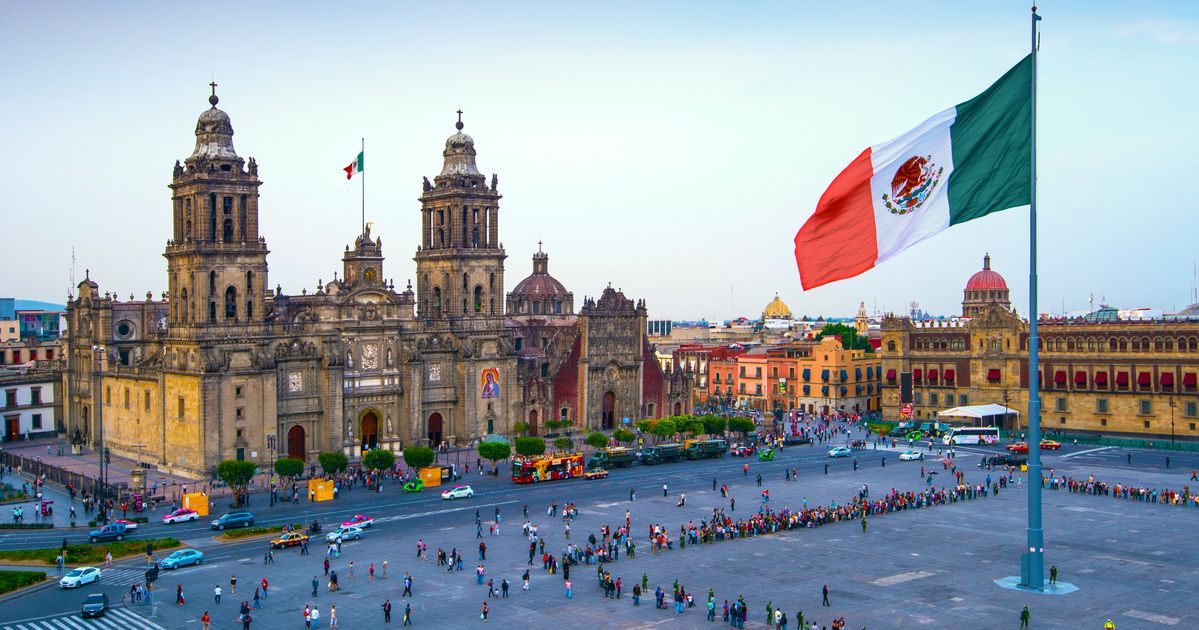Mexico City’s appeal as a tourist destination is obvious. Ciudad de México boasts an incredible culinary scene, world-class museums, historic sites and more.
But as with any place with a large tourism industry, it’s common for visitors to make certain mistakes ― and the locals are in a position to see all of it. We asked people who live in Mexico City, from expats to natives, to share some of the faux pas they’ve observed.
From misjudging spice to forgetting about altitude sickness, here are 20 mistakes tourists often make while visiting Mexico City ― and some advice for avoiding these errors during your travels.
Expecting everyone to speak English
“Try to learn a little bit of Spanish before arriving, just basics like good morning, hello, etc. Approaching someone with only English seems a bit rude even if most of us speak fluently.” ― Anais Martinez, culinary tour guide and blogger at The Curious Mexican
“It’s a mistake to assume that everywhere you go in Mexico City, people will speak English. While many people in the city do, it’s much more considerate and appropriate to learn at least a few phrases in Spanish: Good morning! Nice to meet you! How much does this cost? Do you speak English? Can you help me?” ― Lydia Carey, writer and tour guide
Only staying downtown
“Most tourists I know think the best is to stay downtown near Avenida Reforma and the Angel of Independence, but there are many other amazing neighborhoods in the city with more folklore and color, like Coyoacan with its amazing artisan markets and delicious churros, and Condesa and Roma with lovely parks, art galleries and yummy bakeries.” ― Gabilú Mireles, personal coach and motivational speaker
Thinking “salsa” refers to a dip
“When you arrive at a Mexican restaurant, the server will probably bring some different kinds of salsa to your table. Unlike what happens north of the border, this is not intended as an appetizer for you to dip your chips in. Salsa is not a dip, it’s a condiment intended for you to spice up your food for the remainder of the meal. Use the spoon provided, don’t dunk.” ― Max St Romain, food and travel blogger at Gastronauta DF
Assuming U.S. dollars or credit cards are accepted everywhere
“Bring cash to markets, as most likely no one will take cards. Also, bring pesos; we don’t accept USD in the city.” ― Martinez
“Don’t assume that you can use dollars anywhere in the city. And when you tip someone with dollars, not only is it a pain for them to change that money, but they will always lose money in the transfer. Better to use pesos, which are easy enough to get from a local ATM. That sounds pretty obvious, but many visitors from the U.S. and Canada have asked me that question.” ― Carey
Drinking in the streets
“It’s illegal to drink alcohol in the streets of Mexico City. We understand people travel here as a vacation, to relax and have a good time, but if the cops see you drinking in the streets they will be on you. They might tell you just to stop doing it, but also could be more problematic, depending on the cop’s attitude and yours ― but better try to avoid that.” ― Ubish Yaren, owner of Mexico Underground
John Coletti via Getty Images
Falling victim to “Montezuma’s revenge”
“Mexico City has one of the richest gastronomies in the world ― street food, tacos, mole and guacamoles, among others. However, travelers should not get excited and want to try everything in one day, as they will probably suffer from Montezuma’s revenge, which refers to getting sick after eating. Indeed, the food in the CDMX can be very delicious, but some stomachs are not used to certain ingredients. So it is best not to overdo it.” ― Marisol Herrera, co-founder and commercial alliances coordinator at travel platform Rutopia
“There are a number of foods to be careful with, such as lettuce, strawberries or the ever-present cilantro. But one food that most people don’t consider is cheese. The risk comes in the form of farm cheese (‘queso de rancho’), which includes ‘quesillo,’ a broadly used style of string cheese, frequently sold in carts throughout the city and commonly used in street food. The problem comes with the fact the cheese is made with unpasteurized milk, and foreigners do not have the antigens in their system that the locals have.” ― St Romain
Forgetting about altitude sickness
“Many people forget to check on this whenever they travel, and even before being in Mexico City, altitude sickness can be very annoying if you start drinking from your flight to Mexico City. For most people, this will be just headaches and getting out of breath when climbing stairs. For others [it] can be harder, so ask your doctor and bring pills just in case.” ― Yaren
Packing for strictly sunny and hot weather
“Sun, beach and a good mezcal is the first thing that comes to mind when we think about Mexico. However, the weather is not always sunny in all the country. A common mistake is not to realize that it can rain on the same day or even at night when the temperature can drop. Many tourists pack T-shirts and shorts for their visits, but in the evenings, they will indeed look for a jacket to cover themselves from the cold. So, do not forget a coat, an umbrella and a cap to enjoy the journey through the city.” ― Sebastian Muñoz, co-founder and chief procurement officer of Rutopia
Having rigid time expectations
“Mexican culture operates at later times than other societies, like the U.S. People start work shifts later, not all stores open early, and meals are eaten later than you might be accustomed to. Most people eat lunch around 2 or 3, while it’s not unusual to start dinner as late as 10 p.m. And leave room for late-night tacos. Bear this in mind when booking restaurants or scheduling with locals. Also, be aware that punctuality is very fluid here, so budget in some tolerance.” ― St Romain
Underestimating salsa heat
“When tourists come to Mexico, they are unaware of the possibility of salsas being too hot. What we suggest is, first of all: ASK. When presented with the different options, they should ask: ‘¿Qué salsa pica más?’ (Which salsa is the hottest?) Generally, the person in charge will put them in order, from the hottest (‘la que más pica’) to the mildest (‘la que menos pica’). Once the tourist has this information, we suggest they put the tip of their pinky in the salsa, and this drop should fall on their palm. Cautiously, they should try it with their tongue to make sure it is edible. If it is too hot, avoid drinking water. The best option is eating bread or tortilla, or something that will absorb the ‘hot’ of the salsa. If not, adding a few drops of salsa to the food or taco is now in order!” ― Angeles Perez, co-owner and client services leader at Eat Mexico
“Red salsa won’t always be the hottest option ― sometimes green can be full of heat, so always try them out before you drown your food in any of the available options.” ― Martinez
Thinking you can’t have ice at a restaurant
“It’s true. We don’t drink tap water. Most people buy bottled water for their homes in huge jugs called ‘garrafones.’ When you should worry about the water? Basically only when buying drinks from questionable places on the road, country or backstreets. All professional restaurants will always have either filtered or bottled water on hand, and the same goes for ice. Most restaurants do not have ice machines, so they buy from ice providers, which means purification is guaranteed. Telling people you don’t want ice because you’re afraid of getting sick is almost like implying the source is dirty, and that comes across as offensive.” ― St Romain
Constantly talking about the prices
“It’s rude and ethnocentric to constantly talk about how cheap things are here. Even if it is cheap comparatively for you, coming from where you live, just keep those thoughts to yourself ― what might be cheap for you may be expensive for people on the ground.” ― Carey
Missing out on local favorites
“Always get recommendations from a local if you can, someone with experience and time lived in the city. There are a lot of hotels and restaurants out there with killer PR firms pushing their product abroad, but just because you read about something in a travel magazine doesn’t mean it’s worth your time or stomach space.” ― Carey
“Mexico City has a vast food offer, with more and more chefs and culinary creatives opening their own versions of Mexican food, especially the bakeries! Wake up early and sit down to enjoy a café con leche and concha!” ― Mireles

Glow Images via Getty Images
Slamming car doors
“For some reason, most foreigners completely slam car doors when closing them. Most Uber riders here would get a bit upset when this happens, so try to be a bit gentle.” ― Martinez
Misjudging distance and time
“A common mistake is not taking traffic seriously. Mexico City hosts 22 million people, and almost 10 million cars (registered in Mexico City and surrounding areas). Therefore, traffic is pretty complicated. With COVID-19, traffic was reduced greatly, but since 2021, traffic has steadily increased and has reached pre-pandemic numbers. For this reason, tourists should make sure they take this into consideration when moving around the city so they do not lose tours, reservations, etc.” ― Perez
“It’s a mistake to think that Mexico City is not that big and you can visit the Pyramids of Teotihuacan and Xochimilco on the same day ― that’s not possible, doable or fun. The traffic in Mexico City can change at any minute, so be very mindful of your times. You might see that the restaurant that you are going [to] is a couple of miles from you, but that can easily be a one-hour Uber ride.” ― Yaren
Discounting the city’s more recent history
“Mexico City is much more than the Aztec Empire and Spanish colonialism. Those things happened over 500 years ago, and there has been a lot going on since that time. Take the time (before you come or while you are here) to investigate a little bit about the city’s contemporary history ― it is rich, interesting, and an important part of what makes this place special.” ― Carey
Not bringing a mask
“Even that now COVID seems over, still many places require you to wear it, so bring a face mask just in case always.” ― Yaren
Taking the metro during rush hour
“There are many options to move around the CDMX, such as the subway, which offers excellent connectivity between areas. However, it is used by locals, which means that ‘la hora pico’ is complicated even to enter the subway. Therefore, we can say that the rule for any tourist visiting CDMX is that under no circumstances should you use the metro during rush hour. Keeping this factor in mind in CDMX will help avoid falling into the trap and optimize resources and time, which never hurts on a trip.” ― Emiliano Iturriaga, general director at Rutopia
Trying to cram too much into a short trip
“When visiting the CDMX, investing time and organizing the trip is essential. The distance between attractions is considerable, and one day is not enough to know CDMX. Some travelers realize this when they arrive and want to extend their stay in this city. We are sure travelers do not want to spend all their holiday in transportation, facing setbacks such as traffic, strikes, long lines, or simply realizing that to visit a place in the CDMX such as museums or parks, one can spend a whole day in them. Therefore, we recommend reducing the list of attractions to visit. That way, one can better appreciate the interests and immerse in the city’s atmosphere.” ― Jorge Reyna, product manager at Rutopia
“Mexico City is not a quick bite, it’s huge feast. There is so much to do, so much to see, so much to eat, so don’t expect to have a faithful CDMX experience in only a couple of days.” ― St Romain
Letting your guard down
“As with any big city, you must beware crime and pickpocketers, so just take your precautions, don’t wave your new iPhone around (especially if using the subway system), take care of your belongings and always choose a car app like Uber over a taxi down the street. You can also ask your hotel for a safe taxi company you can use.” ― Mireles
“Safety is a concern to a lot of travelers, but the word takes on many meanings. Like most major cities, crime is a reality, but your risk will be reduced by being aware of your surroundings and how you present yourself. Avoid drawing attention to yourself, especially displaying expensive items or money. Put away that iPhone while you walk or in public transport. Like at the airport, don’t lose sight of your belongings. But also, for your physical safety, stay alert: Don’t rely on traffic lights to cross the streets, as you must be a defensive pedestrian. Watch your step as you walk, as sidewalks may not be in the best condition. All in all, commonsense stuff ― just don’t rely on how things work back home to navigate this town.” ― St Romain


